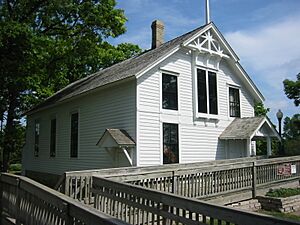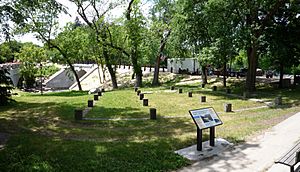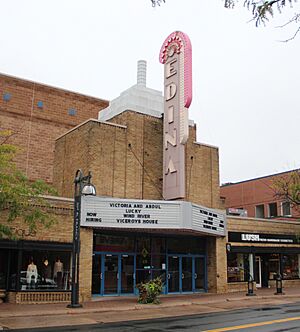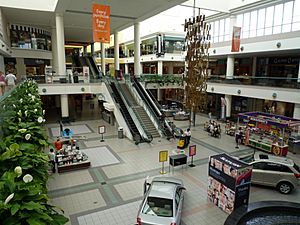Edina, Minnesota facts for kids
Quick facts for kids
Edina
|
||
|---|---|---|
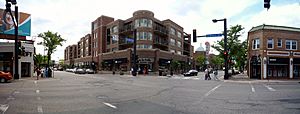
50th & France
|
||
|
||
| Motto(s):
"For Living, Learning, Raising Families & Doing Business"
|
||
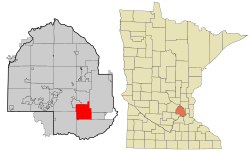
Location of Edina
within Hennepin County, Minnesota |
||
| Country | United States | |
| State | Minnesota | |
| County | Hennepin | |
| Founded | 1860s | |
| Incorporated | 1888 | |
| Area | ||
| • City | 15.96 sq mi (41.34 km2) | |
| • Land | 15.46 sq mi (40.03 km2) | |
| • Water | 0.51 sq mi (1.31 km2) 3.26% | |
| Elevation | 922 ft (281 m) | |
| Population
(2020)
|
||
| • City | 53,494 | |
| • Estimate
(2022)
|
52,437 | |
| • Rank | US: 766th MN: 19th |
|
| • Density | 3,461.05/sq mi (1,336.31/km2) | |
| • Metro | 3,693,729 (US: 16th) | |
| Demonym(s) | Edinans (official) Cake Eaters (nickname) |
|
| Time zone | UTC−6 (Central) | |
| • Summer (DST) | UTC−5 (CDT) | |
| ZIP codes |
55410, 55416, 55424, 55435, 55436, 55439, 55343
|
|
| Area code(s) | 952 | |
| FIPS code | 27-18188 | |
| GNIS feature ID | 0643177 | |
Edina (pronounced ee-DY-nuh) is a city in Hennepin County, Minnesota, United States. It's a close-by suburb of Minneapolis. In 2020, about 53,494 people lived there, making it the 18th largest city in Minnesota.
Edina started as a small community for farming and milling in the 1860s. It was built along Minnehaha Creek. In 1888, it became one of Minneapolis's first official suburbs. After being a place where people used streetcars to get around, Edina grew even more in the 1950s and 1960s as more people started driving cars.
Today, Edina is known for its many shops, beautiful parks, and a high quality of life. It is also home to the oldest indoor mall in the country, the Southdale Center.
Contents
History of Edina
How Edina Was Settled
Edina was first part of a larger area called Richfield Township. In the 1870s, many families came to Minnesota and settled here. Most of them were from Ireland, moving after the Great Famine. Later, settlers from New England and Germany also arrived. They claimed land near Minnehaha Creek.
Some of the first areas to be settled were the Baird and Grimes neighborhoods. These are now listed on the National Register of Historic Places. The Country Club District, once called Waterville Mills, was also an early community. The Cahill Settlement, near West 70th Street and Cahill Road, was another important early center. It was home to the Cahill School. In 1888, people in the township decided to form their own village. This way, they could separate from Richfield Township.
Choosing the Name "Edina"
After deciding to form a new village, people debated what to name it. Meetings were held at the Minnehaha Grange Hall. Some names suggested were Hennepin Park, Westfield, and Edina.
During one meeting, Andrew Craik suggested the name Edina. He had moved from Edinburgh, Scotland, in 1869 and renamed the local mill to the Edina Mill. After some discussion, the name Edina was chosen by a vote of 47 for and 42 against.
There's a common story that the Irish Cahill community and the Scottish Mill community argued over names like Killarney Lakes (Irish) or Edina (Scottish). However, old records show that very few Scottish people lived in Edina when it was founded in 1888. The name "Edina" might also come from the language of the nearby Dakota tribe. The word Dakota: Idéna means "to catch fire."
The Story of Morningside Village
The first suburban area in Edina was Morningside. This neighborhood grew in the early 1900s. As Morningside got bigger, its residents wanted more city services. But other people in Edina wanted to keep the village more rural. Because of this disagreement, Morningside separated from Edina in 1920. It became its own village. However, in 1966, Morningside became part of Edina again.
Early Communities and Changes
Edina was not the very first settlement in its spot. Before Edina, there was a Quaker village. This village included African American families, some of whom were Civil War veterans or freed slaves. These families were very involved in community life. They owned farmland and were leaders in the community. In 1898, an African American man named J. Frank Wheaton was elected to the Minnesota House of Representatives. He represented the area that included Edina. He won even though there were only about 100 African American residents in his district of 40,000 people.
In the early 1900s, as Edina grew, some new rules were put in place. These rules made it hard for African American families to live in certain areas. This caused almost all the African Americans who had been living in Edina to move away. Some neighborhoods had rules in their property deeds that said only white people could live there. These rules were meant to protect property values.
In 1948, the Supreme Court said these kinds of rules were not legal. But even after that, some unfair practices continued into the 1950s and 1960s. For example, when the first Black family moved to Morningside (which was a separate village then) in 1960, some people tried to stop them. But the mayor at the time, Ken Joyce, encouraged people to treat each other fairly. Soon after, the village voted to be more welcoming to everyone. Jewish residents also faced similar unfair rules in the past.
Geography of Edina
Edina covers about 15.97 square miles (41.34 square kilometers). Most of this area, about 15.45 square miles (40.03 square kilometers), is land. The rest, about 0.52 square miles (1.31 square kilometers), is water. Most of the city is now developed, with homes making up the largest part.
Edina has many different neighborhoods. Some of them are Highlands, Indian Hills, Morningside, Country Club District, Cahill Village, Chapel Hill, South Harriet Park, Interlachen, Rolling Green, Presidents, Sunnyslope, White Oaks, Parkwood Knolls, Braemar Hills, Birchcrest, Dewey Hill, and Hilldale.
People of Edina (Demographics)
| Historical population | |||
|---|---|---|---|
| Census | Pop. | %± | |
| 1890 | 531 | — | |
| 1900 | 749 | 41.1% | |
| 1910 | 1,101 | 47.0% | |
| 1920 | 1,833 | 66.5% | |
| 1930 | 3,138 | 71.2% | |
| 1940 | 5,855 | 86.6% | |
| 1950 | 9,744 | 66.4% | |
| 1960 | 30,482 | 212.8% | |
| 1970 | 44,031 | 44.4% | |
| 1980 | 46,073 | 4.6% | |
| 1990 | 46,075 | 0.0% | |
| 2000 | 47,425 | 2.9% | |
| 2010 | 47,941 | 1.1% | |
| 2020 | 53,494 | 11.6% | |
| 2022 (est.) | 52,437 | 9.4% | |
| U.S. Decennial Census 2020 Census |
|||
Edina's Population in 2020
| Race / Ethnicity | Pop 2000 | Pop 2010 | Pop 2020 | % 2000 | % 2010 | % 2020 |
|---|---|---|---|---|---|---|
| White alone (NH) | 44,367 | 41,535 | 42,158 | 93.55% | 86.64% | 78.81% |
| Black or African American alone (NH) | 527 | 1,424 | 1,892 | 1.11% | 2.97% | 3.54% |
| Native American or Alaska Native alone (NH) | 61 | 78 | 91 | 0.18% | 0.16% | 0.17% |
| Asian alone (NH) | 1,408 | 2,914 | 4,809 | 2.97% | 6.08% | 8.99% |
| Pacific Islander alone (NH) | 11 | 16 | 7 | 0.02% | 0.03% | 0.01% |
| Some Other Race alone (NH) | 48 | 88 | 231 | 0.10% | 0.18% | 0.43% |
| Mixed Race/Multi-Racial (NH) | 464 | 785 | 2,304 | 0.98% | 1.64% | 4.31% |
| Hispanic or Latino (any race) | 539 | 1,101 | 2,002 | 1.14% | 2.30% | 3.74% |
| Total | 47,425 | 47,941 | 53,494 | 100.00% | 100.00% | 100.00% |
Note: The US Census counts Hispanic/Latino as an ethnic group. This table separates them from racial categories.
Edina's Population in 2010
In 2010, Edina had 47,941 people living there. There were 20,672 households and 12,918 families. The city had about 3,103 people per square mile (1,198 per square kilometer).
The racial makeup was mostly White (88.1%). There were also African American (3.0%), Native American (0.2%), and Asian (6.1%) residents. About 2.3% of the population was Hispanic or Latino.
About 29.4% of households had children under 18. The average household size was 2.31 people, and the average family size was 2.98 people. The median age in the city was 45.2 years. About 24.2% of residents were under 18, and 20.7% were 65 or older.
Places of Worship
Edina has several places of worship. The Venkateswara Temple serves the Hindu community in the Minneapolis-St Paul area. Christ Presbyterian Church is a large Presbyterian church. Edina Community Lutheran Church (ECLC) is a Lutheran church that has been in Edina since 1948.
Edina's Economy
Several large companies have their main offices in Edina. These include Jerry's Foods, Lund Food Holdings, Edina Realty, Regis Corporation, Dairy Queen, and Orange Julius.
The city has popular shopping areas. These include Southdale Center, Galleria Edina, and 50th & France. The 50th & France area is shared with Minneapolis.
Some of the biggest employers in Edina are Fairview Southdale Hospital, Edina Public Schools, and the City of Edina itself. Other major employers include BI Worldwide, Regis, Barr Engineering, Lund Food Holdings, International Dairy Queen Inc., SunOpta, Edina Realty, and FilmTec Corporation.
Sports in Edina
Edina is well-known for its strong ice hockey programs for both boys and girls. In 2020, ESPN even called Edina the "center of the center" of American ice hockey. Since 2016, Edina's Braemar Ice Rink has hosted Da Beauty League. This is a 4-on-4 ice hockey league where professional players from the NHL and other leagues play to stay in shape during the offseason.
In December 1979, the first bandy game in the USA was played in Edina. Bandy is a sport similar to ice hockey, played with a ball instead of a puck. The game took place at Lewis Park Bandy Rink.
Parks and Recreation in Edina
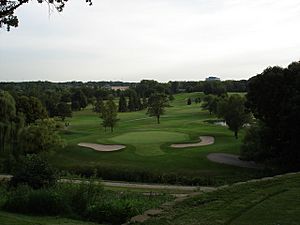
Parks and Green Spaces
Edina has more than 1,550 acres (6.27 square kilometers) of parks and open spaces. The Edina Park and Recreation Department manages 44 parks. These parks have many features like fields for baseball, football, and soccer. They also have softball diamonds, basketball and tennis courts, and outdoor ice skating rinks. You can find playgrounds for younger kids and picnic shelters too.
The department also takes care of eight miles (13 kilometers) of beautiful paths. These paths are great for bicycling, walking, jogging, cross-country skiing, and snowshoeing.
Recreation Facilities
Besides the parks, the Edina Park & Recreation Department also runs 10 arts, community, and recreation places. These include Braemar Golf Course, Braemar Ice Rink, Centennial Lakes Park, and Edinborough Park.
The Three Rivers Park District, which manages regional parks in Hennepin County, also operates the Nine Mile Creek Regional Trail through Edina.
Waterways and Country Clubs
Two important waterways in the Twin Cities area flow through Edina. These are Minnehaha Creek and Nine Mile Creek. They both eventually reach the Mississippi and Minnesota Rivers. Both creeks are part of major regional parks and trails.
Edina also has two country clubs: the Edina Country Club and the Interlachen Country Club.
Education in Edina
Public Schools
Edina Public Schools is the public school district for Edina. It serves about 8,500 students from kindergarten through 12th grade. The district has over 1,100 teachers and staff.
Edina has one high school, Edina High School. There are two middle schools: South View Middle School and Valley View Middle School. The city also has six elementary schools: Concord, Creek Valley, Cornelia, Highlands, Countryside, and Normandale.
Private Schools
There are three private schools in Edina: Our Lady of Grace Catholic School, Golden Years Montessori, and Avail Academy-Edina Campus.
Colleges
Edina is home to a satellite campus of Minnesota State University, Mankato.
Transportation in Edina
Major Roads
Many major highways run through or near Edina. This makes it easy to get to from other parts of the Twin Cities metropolitan area. Minnesota State Highways 62 and 100 divide the city into four sections. U.S. Route 169 and Minnesota State Highway 100 go north and south. Interstate 494 and Minnesota State Highway 62 go east and west.
Public Transit
Before 1954, a streetcar line called the Lake Minnetonka Line went through Edina. After streetcar service stopped, homes were built on the old streetcar path.
Bus Service
Metro Transit operates daytime buses in Edina. These buses mainly run along France Avenue and through business parks near Interstate 494. Edina's Southdale Transit Center is an important bus hub for the southwest Twin Cities.
The E Line is a new rapid bus route planned to connect the University of Minnesota to the Southdale Transit Center in Edina. It is expected to start operating by 2026.
Commuter Rail
A train line called the Dan Patch Line used to offer passenger service through Edina until 1942. While the tracks are still used by freight trains, they are not in good condition. There have been ideas to use these tracks for commuter trains between Minneapolis and Northfield, with a stop in Edina. However, this project has faced challenges, including high costs and opposition from residents living near the tracks. In 2023, a law that stopped discussions about this project was removed.
Famous People from Edina
Many notable people have lived in or are connected to Edina. Here are a few:
- David W. Anderson – founder of Famous Dave's restaurants
- Kieffer Bellows – NHL hockey player
- Dorothy Benham – Miss America, 1977
- Paris Bennett – American Idol contestant
- David Bloom – NBC television journalist
- Paige Bueckers - top high school basketball player
- Corinne Buie - professional ice hockey player
- Lois McMaster Bujold – science fiction author
- Brian Burke – NHL hockey executive
- Curt Carlson – founder of Carlson Companies
- Leeann Chin – founder of Leeann Chin Chinese Cuisine
- Ike Davis – baseball player
- John Denver – singer and activist
- R. A. Dickey – baseball player and Cy Young Award winner
- Julia Duffy – actress
- Fredrik Eklund – real estate broker and TV personality
- Joe Finley – professional ice hockey player
- Craig Finn – lead singer for The Hold Steady
- Mardy Fish – professional tennis player
- Ric Flair – professional wrestler
- P. J. Fleck – head coach of Minnesota Golden Gophers Football
- Emily Fridlund – author
- Adam Goldberg – NFL football player
- Judith Guest – novelist and screenwriter
- John Harris – professional golfer
- Tippi Hedren – actress
- Ron Johnson – former CEO of J.C. Penney
- Ben Leber – NFL player and sports radio personality
- Anders Lee – NHL hockey player
- Bobby Lee – actor and comedian
- Nicholas Legeros – bronze sculptor
- Hilary Lunke – professional golfer
- Reggie Lynch – basketball player
- Jamie McBain – NHL hockey player
- Karl Mecklenburg – NFL football player
- George Mikan – former professional basketball player
- Casey Mittelstadt – NHL hockey player
- Riddick Moss – professional wrestler
- Lou Nanne – former NHL player and general manager
- Bill Nyrop – former NHL player
- Greg Olson – former professional baseball player
- Mary Pawlenty – attorney and judge
- Barbara Peterson – Miss USA 1976
- Paul Peterson – musician
- Zach Parise – professional ice hockey player
- Carl Pohlad – former owner of the Minnesota Twins
- Jenny Potter – Olympic gold medalist in ice hockey
- Kirby Puckett – former baseball player for the Minnesota Twins
- Paul Ranheim – former NHL hockey player
- Kaylin Richardson – World Cup Alpine Skier, Olympian
- Doug Risebrough – former General Manager of the Minnesota Wild
- Laura Rizzotto – singer, songwriter
- Richard M. Schulze – founder of Best Buy
- Joe Senser – former NFL player
- Jennifer Steinkamp – artist
- Christopher Straub – fashion designer
- Michele Tafoya – sportscaster
- Robert Ulrich – former chairman and CEO of Target Corporation
- Paul Westerberg – musician, frontman for The Replacements
- Andrew Zimmern – chef and TV host
- Jason Zucker – NHL hockey player
See also
 In Spanish: Edina (Minnesota) para niños
In Spanish: Edina (Minnesota) para niños





